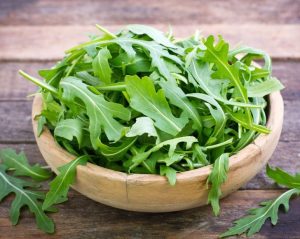“I can only guess that my neighbors don’t cook.”
That’s what one of our fellow organic farmers at Salvaterra Gardens told Farmer Reuben this week.
He’s a great grower—hardworking, passionate, and producing beautiful organic vegetables. But like us, he’s struggling to sell enough to keep his farm going.
What’s most frustrating? The people who live right across the road from his farm don’t even walk over to buy from him.
The freshest, most nutrient-dense food—including organic strawberries, probiotic dairy, and pastured meats—is just steps away, and yet, many still choose convenience-store produce shipped from across the country.
It makes you wonder:
Do they even cook?
Or have they become so disconnected from real food that they no longer recognize its value?
At Willow Haven Farm, we understand that small farms can’t survive on passion alone. It takes people like you—conscious, committed eaters—who are willing to support local farmers by choosing seasonal produce, fresh dairy, and local meats every week.
When you become a part of our Market Box CSA or shop at our General Store, you’re doing more than feeding your family. You’re helping build a stronger local food system—one that includes farmers like:
🌱 Salvaterra Gardens, Alburtis – Growing exceptional organic vegetables just miles from your home
🥛 Flint Hill Dairy Farm, Coopersburg – Creating small-batch, probiotic-rich yogurts and kefir to support your gut health
🥩 Harvest Home Meats, Nazareth – Raising 100% grass-fed beef and pastured pork with integrity and care
These farmers are our partners in your health.
Together, we grow the food your body needs—without the shortcuts, chemicals, or compromises of industrial agriculture.
If you’re looking for fresh ideas for organic strawberries, probiotic dairy, and local meats, you’ll find them in the meal tips and recipes that follow—rooted in what’s truly seasonal and local.
Want to support them all in one easy step?
Join our Market Box CSA or upgrade to the Farmer’s Favorites Large to get more seasonal vegetables and local goods each week—automatically.
FEATURED: Probiotic Dairy from Flint Hill Farm
This week, we’re featuring probiotic dairy products from our friends at Flint Hill Farm. These cultured dairy staples are creamy, tangy, and brimming with gut-friendly probiotics that support digestion, immune function, and nutrient absorption. Rich in calcium, B vitamins, and high-quality protein, they make a satisfying and nutrient-dense base for both sweet and savory meals. Kefir is drinkable and tart with a broad spectrum of beneficial bacteria—great on its own or blended into smoothies. Buttermilk (especially the traditional cultured kind) has a thinner texture and bright acidity that shines in dressings, marinades, and baked goods. Yogurt is endlessly versatile, from spoonable bowls to dips, sauces, and marinades. All three help balance the microbiome, and pair beautifully with fiber-rich seasonal produce for a well-rounded, nourishing boost to any meal.
FEATURED: Strawberries
There’s no question that we’re moving toward early summer when sweet, vibrant, local strawberries are available! These juicy red gems are bursting with vitamin C, fiber, and antioxidants like anthocyanins and ellagic acid, which support heart health, promote glowing skin, and reduce inflammation. Their natural sweetness and subtle acidity make them equally at home in simple snacks or as the star of a more composed dish. Use them raw, roasted, or simmered into a sauce. They’re especially good when paired with cultured dairy for a seasonal probiotic boost.
💡Pro Tip: To keep strawberries fresher longer, rinse them in a mix of 1 part white vinegar to 3 parts water, then dry thoroughly before storing. This helps remove bacteria and mold spores that speed up spoilage—your berries will stay bright and delicious for days longer. (Don’t worry—the vinegar smell disappears once they dry!)
MEAL IDEAS FOR YOUR LOCAL ORGANIC FOOD THIS WEEK:
Many of these recipes include produce or other items you may have received in your market box. You may also see ingredients you can purchase at the WHF General Store. Experiment and see what you can use to create your meal plan!
💡Pro tip: Always check your recipes to see what you have and what you need to purchase. Takes a few extra minutes in planning, but it beats finding out at the last minute that you’re missing ingredients!
This time of year brings a fresh wave of flavor with juicy strawberries, crisp greens, and tangy cultured dairy. This week, we’re pairing probiotic-rich staples like kefir, yogurt, and buttermilk with vibrant seasonal produce and pasture-raised meats to create meals that are as nourishing as they are delicious.
🥣 Berry Yogurt Bowls with Greens & Granola
Top a scoop of yogurt with sliced strawberries, toasted granola, and a handful of torn spinach or baby arugula. A drizzle of honey or rhubarb compote adds brightness, while the greens bring a refreshing balance and fiber to support gut health.
🥤 Kefir Smoothie with Ginger, Nettle & Berries
Blend kefir with blanched stinging nettle, fresh ginger, strawberries, and banana or apple. This smoothie is cooling, anti-inflammatory, and energizing—perfect for a light breakfast or afternoon pick-me-up.
🥣 Strawberry Kefir Smoothie with Beet or Rhubarb Add-In
Blend strawberries and kefir with banana and a spoonful of roasted beet or stewed rhubarb. Earthy, sweet, and probiotic-rich. Serve with a hard-boiled egg or nut butter toast for a light meal.
🍓 Strawberry Rhubarb Yogurt Parfaits
Layer roasted rhubarb, fresh strawberries, and thick yogurt in a glass. Top with chopped nuts, granola, or oats for texture. This sweet-tart treat is both satisfying and loaded with antioxidants, protein, and beneficial bacteria.
🥞 Probiotic Pancakes with Strawberry Rhubarb Compote
Top your favorite pancakes with a quick strawberry-rhubarb compote simmered with a splash of maple syrup. For a tangy, tender twist, make the batter with buttermilk or kefir—both add depth of flavor and a probiotic boost. Serve with extra strawberries or a dollop of yogurt for a full cultured dairy celebration.
🥬 Savory Kefir Dressing over Spring Greens
Blend kefir with garlic chives, green onion, lemon juice, and olive oil for a probiotic ranch-style dressing. Pour over butterhead lettuce, watercress, and shaved asparagus, then top with pastured egg or grilled chicken for a creamy, tangy, nutrient-dense meal.
🥗 Arugula & Strawberry Salad with Tangy Poppyseed Dressing
Peppery arugula, sliced strawberries, toasted nuts, and goat cheese drizzled with tangy probiotic buttermilk or kefir poppyseed dressing. Serve alongside grilled chicken or pork chops for a sweet-savory, gut-friendly pairing.
🍗 Buttermilk-Marinated Grilled Chicken with Strawberry-Ginger Relish
Soak chicken thighs in a probiotic buttermilk marinade with garlic chives and spices, then grill and top with a bright relish of diced strawberries, cilantro, green onion, and fresh ginger. Tender, juicy, and loaded with flavor and digestive support.
🐟 Salmon over Bok Choy Slaw with Yogurt-Ginger Sauce
Pan-sear wild salmon and serve over a crisp slaw of bok choy, Napa cabbage, cilantro, and green onion. Finish with a yogurt sauce flavored with fresh ginger and garlic chives for a bright, gut-friendly way to enjoy healthy fats and fiber together.
🌮 Grilled Portobello Tacos with Buttermilk Crema
Marinate and grill Portobello caps, then slice and tuck into tortillas with sautéed kale or spinach, cherry tomatoes, and a dollop of garlic buttermilk crema. This meatless main is rich, zesty, and boosted with probiotics and seasonal greens.
💡Tip: To make a quick buttermilk crema, mix ½ cup plain Greek yogurt with 2–3 tablespoons buttermilk until smooth and pourable. Add a pinch of salt and lime juice to taste. Let it sit for 10–15 minutes to thicken slightly. Use it over tacos, grilled vegetables, or spicy dishes for a tangy, cooling finish.
🍄🟫 Portobello Mushrooms with Balsamic Strawberries & Herbed Yogurt
Roast or grill mushrooms and top with strawberries simmered in balsamic vinegar, then finish with herbed yogurt. Add a grilled steak or pastured sausage for a satisfying, probiotic-boosted plate. An herbed goat cheese would also be delicious in place of the yogurt.
🥬 Lion’s Mane Sauté with Kale, Ginger & Yogurt Sauce
Cook Lion’s Mane mushrooms and Red Russian kale with fresh ginger and olive oil. Finish with a spoonful of seasoned yogurt. Serve alongside pan-seared steak, pork chops, or lentil patties.
🥩 Beef, Pork, or Lamb Meatballs with Yogurt-Herb Sauce
Make meatballs with ground pastured meat, green onion, and garlic chives, and serve over sautéed collards or spinach with a lemony yogurt-herb sauce. It’s comforting, balanced, and a great way to bring probiotic brightness into a hearty meal.
🧆 Gingered Beef Meatballs with Bok Choy & Yogurt Sauce
Make spiced beef meatballs with fresh ginger and green onion. Bake and serve over sautéed bok choy with a drizzle of seasoned yogurt for a savory, tangy-probiotic finish.
💡Tip: These meatballs work just as well with ground turkey for a lighter twist—just be sure not to overcook, as turkey dries faster than beef.
🍳 Bitter Greens & Rhubarb Hash with Eggs + Yogurt Dollop
Sauté chopped red beets, collard greens, and rhubarb with onion and garlic chives. Top with a poached or fried egg and a dollop of tangy plain or herbed yogurt to mellow the bitterness and add probiotic creaminess.
🍠 Sweet Potato Mash with Buttermilk & Garlic Chives
Whip roasted fingerling sweet potatoes with probiotic buttermilk, garlic chives, and black pepper. Creamy and tangy—serve as a nourishing side with meatballs, roast chicken, or grilled salmon.
🥒 Kefir-Marinated Grilled Veggies
Toss sliced cremini mushrooms, cherry tomatoes, and green onions in kefir with garlic chives, salt, and a pinch of cumin. Let them marinate 30–60 minutes, then grill or roast. The kefir tenderizes and infuses the vegetables with gentle acidity and probiotic goodness. Great alongside grilled meats or in a grain bowl.
🍓 Strawberry Rhubarb Chutney
Simmer strawberries, rhubarb, onion, ginger, and a splash of red wine vinegar into a tangy-sweet chutney. It pairs beautifully with grilled pork chops, sausages, or a wedge of sharp cheddar cheese.
BREAD & BAKERY:
- Add a loaf (or two) to your market box. Our hearty sourdough bread makes delicious toast and is a great partner for soups, salads, and egg dishes.
- 💡Tip: Make sure you never run out of your favorite bread with our Sourdough Bread Subscription.
- Check out our selection of sourdough pastries. Choose from sourdough croissants, cinnamon rolls, scones, and the famous chocolate hazelnut twist. Yum!
- Grab some of the Farm Girls’ Mexican hot chocolate cookies before they’re gone!
MEAT & SEAFOOD:
- We’re into cookout season! Be sure to pick up your favorite grilling meats. Whether you like salmon burgers, beef burgers, brats, steak, ribs, or chicken on the grill, we’ve got you covered!
- 💡Tip: Add a pack of sourdough brioche rolls if you’re making burgers or brats.
- If you’re preparing meals from the suggestions above, be sure to check out our selection of organic and pastured ground meats, steaks, chicken, pork, and seafood. Add your favorites to create satisfying, nutrient-dense meals.
DAIRY:
- This week’s meal suggestions feature plenty of ways to incorporate Flint Hill Farm’s probiotic-rich buttermilk, kefir, and yogurt into your diet. Add some to your market box order for a nutritious and flavorful way to enhance your meals.
- 💡Tip: These dairy staples are just a few of the options you can select if you add a Dairy Subscription to your weekly order. Look under the Dairy & Eggs section of our Subscriptions page to find your favorites.
- Add some creamy, pasture-raised goat cheese to your order to use for salads, toast, dips, and more. It’s delicious on pizza!
PANTRY:
- Stock up on items from our Ferments & Pickles and Condiments & Dressings sections. We have all you need for preparing delicious summer meals.
- Don’t miss our selection of balsamic vinegars! Delicious for salads, but also great for making glazes to use on your favorite meats, seafood, and pasta!
- 💡Tip: Take advantage of the beautiful first-of-the-season cherry tomatoes to make this 10-minute Cherry Tomato Pasta.
- If you’re making your own salad dressings, check your ingredients and add mustard, maple syrup, honey, oils, vinegar, herbs, and seasonings as needed.
- 💡Tip: Olive oil and red wine vinegar are mentioned in meal ideas above.
HEALTH & HOME:
- If you’re working in the garden or kitchen, Jewelweed Salve is a great item to have handy. Made by our friends at Storms End Homestead, this salve is great for bug bites, nettle stings, poison ivy, minor kitchen burns, and more. Pick up one for the kitchen and one to take along when you’re outside.
- Warm weather means more time outside – and plenty of laundry! Make sure the clothes you wear are as clean as the food you eat. Our Clean Haven laundry detergent is chemical-free and made here at Willow Haven Farm. (Available in liquid or powder.)
FRUIT:
 Strawberries – Juicy, fragrant, and naturally sweet, strawberries are a beloved spring fruit rich in vitamin C, antioxidants, and fiber. Enjoy them fresh as a snack, sliced into salads, blended into smoothies, or baked into crisps and shortcakes. For longer storage, refrigerate unwashed berries in a paper-towel-lined container and wash just before eating. Use within 2–3 days for best flavor and texture.
Strawberries – Juicy, fragrant, and naturally sweet, strawberries are a beloved spring fruit rich in vitamin C, antioxidants, and fiber. Enjoy them fresh as a snack, sliced into salads, blended into smoothies, or baked into crisps and shortcakes. For longer storage, refrigerate unwashed berries in a paper-towel-lined container and wash just before eating. Use within 2–3 days for best flavor and texture.
Fun Fact: Strawberries are the only fruit with seeds on the outside—about 200 per berry! To quickly hull them, insert a straw from the bottom and push up through the top.
💡Zero-Waste Tip: Don’t toss the strawberry hulls! Steep them in water for a refreshing infused drink, blend into smoothies for extra fiber, or simmer with other scraps to make a subtly fruity vinegar or syrup base.
Organic Veggies We Harvested This Week:
To help you use everything in your box this week, use this Meal Planning Guide to keep track of what’s in the fridge, what needs to be used first, and what you have planned or prepped for each day.
Every member’s customized Market Box is unique, so we hope you will take advantage of more varieties of vegetables as you get comfortable with all the great organic produce we are offering.
Tessa’s Tips
What to use first: berries, bok choy, chives, green onions, salad greens, mushrooms, tomatoes
Longest Storage: beets, potatoes
Pro-tip: Look at the items in your market box right away and decide how you will use them in your meal planning for the week. Freeze any veggies you know you won’t be able to eat in the week.
Arugula – This leafy green has a peppery, slightly bitter flavor and is commonly used in salads, sandwiches, and as a garnish. It is low in calories and packed with vitamins A, C, and K, as well as folate and antioxidants, which support eye health, immune function, and bone strength. Arugula can be eaten fresh or lightly wilted in pasta dishes and pizzas. Some prefer to eat it tossed with other fresh greens or lettuce so that the spicy taste is not as strong. Putting it on a sandwich is another delicious way to enjoy its distinct flavor. Store wrapped in a paper towel inside a loosely sealed plastic bag in the refrigerator crisper drawer. Properly stored, arugula can stay fresh for up to 3-5 days. For best quality, use arugula soon after purchasing.
💡Tip: Arugula isn’t just for salad. Here are 29 Ways to Eat Arugula including pasta dishes, pizza, sandwiches, and more.
 Asparagus – This spring vegetable is prized for its tender, nutrient-packed stalks. Rich in vitamins A, C, E, K, and folate, asparagus is also a good source of fiber and antioxidants. Its mild, earthy flavor makes it versatile in various dishes, from grilling and roasting to adding to pastas and salads. Asparagus is available in green, white, and purple varieties, with the green being the most common. Store fresh asparagus upright in a jar with a little water in the fridge, or wrapped in a damp towel inside a plastic bag, and use within 3–5 days for the best taste and texture.
Asparagus – This spring vegetable is prized for its tender, nutrient-packed stalks. Rich in vitamins A, C, E, K, and folate, asparagus is also a good source of fiber and antioxidants. Its mild, earthy flavor makes it versatile in various dishes, from grilling and roasting to adding to pastas and salads. Asparagus is available in green, white, and purple varieties, with the green being the most common. Store fresh asparagus upright in a jar with a little water in the fridge, or wrapped in a damp towel inside a plastic bag, and use within 3–5 days for the best taste and texture.
Fun Fact: Asparagus is one of the few vegetables that comes in multiple colors! The green variety is the most commonly consumed, but purple asparagus is sweeter, while white asparagus, grown underground to avoid sunlight, has a milder flavor and more delicate texture.
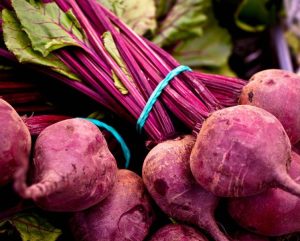
Beet, Red – Red beets are root vegetables known for their earthy flavor and vibrant red-purple color. They are rich in nutrients like folate, manganese, potassium, dietary fiber, and antioxidants such as betalains, which help reduce inflammation and support heart health. Both the roots and greens are edible, with the greens offering additional nutrients like vitamins A and C. Beets can be eaten raw in salads, roasted, boiled, or blended into smoothies and soups. Store beet greens separately from the root, wrapped in a damp cloth or in a plastic bag in the fridge. Use within a few days – they don’t keep long. Beetroots can be stored in a plastic bag in the fridge’s crisper drawer for up to two weeks. To freeze beets for longer storage, slice or chop them, spread on a cookie sheet to flash freeze, then transfer to freezer bags where they can be stored for up to a year.
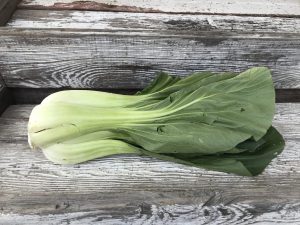 Bok Choy – This leafy green vegetable is a member of the Brassica family. It is rich in vitamins A, C, and K, folate, calcium, and iron. Low in calories and packed with antioxidants, it supports eye health, bone strength, and immune function. Bok choy can be eaten either raw or cooked. With a mild, slightly sweet, and peppery taste, bok choy is versatile in cooking—perfect for stir-fries, soups, and salads. If stir-frying or sautéing, chop the white stalks separately from the green leaves and start cooking the white stalks several minutes before adding the leaves to avoid overcooking the greens. Bok choy can also be grilled by cutting the vegetable lengthwise and drizzling with oil. To store, keep it unwashed in a perforated plastic bag in the refrigerator’s crisper drawer, where it stays fresh for 3-5 days.
Bok Choy – This leafy green vegetable is a member of the Brassica family. It is rich in vitamins A, C, and K, folate, calcium, and iron. Low in calories and packed with antioxidants, it supports eye health, bone strength, and immune function. Bok choy can be eaten either raw or cooked. With a mild, slightly sweet, and peppery taste, bok choy is versatile in cooking—perfect for stir-fries, soups, and salads. If stir-frying or sautéing, chop the white stalks separately from the green leaves and start cooking the white stalks several minutes before adding the leaves to avoid overcooking the greens. Bok choy can also be grilled by cutting the vegetable lengthwise and drizzling with oil. To store, keep it unwashed in a perforated plastic bag in the refrigerator’s crisper drawer, where it stays fresh for 3-5 days.
💡Tip: Dirt often gets trapped in the widest part of the white stalks, so wash it well.
 Cabbage, Chinese (Napa) – Chinese cabbage, also called Napa cabbage, is a tender, pale green variety with a mild, slightly sweet flavor and crisp texture. It’s excellent raw in slaws and salads, quick-pickled for a tangy side, or cooked in stir-fries, soups, dumplings, and fermented as kimchi. Low in calories but rich in fiber, folate, and vitamins C and K, it’s a versatile choice for both fresh and cooked preparations. Store whole heads unwashed in the crisper drawer, loosely wrapped, for up to a week; once cut, use within a few days for best texture and flavor.
Cabbage, Chinese (Napa) – Chinese cabbage, also called Napa cabbage, is a tender, pale green variety with a mild, slightly sweet flavor and crisp texture. It’s excellent raw in slaws and salads, quick-pickled for a tangy side, or cooked in stir-fries, soups, dumplings, and fermented as kimchi. Low in calories but rich in fiber, folate, and vitamins C and K, it’s a versatile choice for both fresh and cooked preparations. Store whole heads unwashed in the crisper drawer, loosely wrapped, for up to a week; once cut, use within a few days for best texture and flavor.
Fun Fact: Napa cabbage has been cultivated in China for over 1,000 years and is one of the most commonly used vegetables in East Asian cuisine, especially in kimchi, where it’s the star ingredient.
💡Tip: Its leaves cook quickly but stems stay crisp, so it’s great for layering texture—try adding it at the end of a stir-fry or soup for a refreshing crunch.
 Cilantro – This fragrant herb has delicate green leaves and a fresh, citrusy flavor. It is widely used in cuisines like Mexican, Indian, and Thai. Cilantro is rich in vitamins A, C, and K, along with antioxidants that support immune health and digestion. It is often used as a garnish, blended into sauces like salsa or chutney, or added to soups and salads for extra flavor. Store cilantro in the refrigerator with the stems in a jar of water, loosely covered with a plastic bag, for up to a week. Alternatively, freeze chopped leaves in ice cube trays with water or oil for longer storage.
Cilantro – This fragrant herb has delicate green leaves and a fresh, citrusy flavor. It is widely used in cuisines like Mexican, Indian, and Thai. Cilantro is rich in vitamins A, C, and K, along with antioxidants that support immune health and digestion. It is often used as a garnish, blended into sauces like salsa or chutney, or added to soups and salads for extra flavor. Store cilantro in the refrigerator with the stems in a jar of water, loosely covered with a plastic bag, for up to a week. Alternatively, freeze chopped leaves in ice cube trays with water or oil for longer storage.
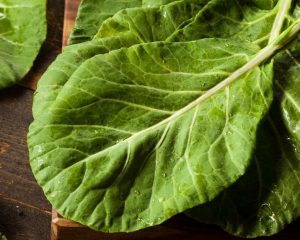 Collard Greens – Collard greens are leafy greens with a slightly bitter, earthy flavor and hearty texture. They are rich in vitamins A, C, and K, calcium, fiber, and antioxidants, which support bone health, immune function, and digestion. Collard greens are often cooked by sautéing, steaming, or simmering in soups and stews, and they’re popular in Southern and African cuisines. Have you used your collard greens to make “lettuce” wraps yet? They hold together better so they are a great substitute. To store, keep collard greens in the refrigerator, wrapped in a damp paper towel inside a plastic bag, where they can stay fresh for up to a week. For longer storage, blanch and freeze them or make green cubes to store for later use.
Collard Greens – Collard greens are leafy greens with a slightly bitter, earthy flavor and hearty texture. They are rich in vitamins A, C, and K, calcium, fiber, and antioxidants, which support bone health, immune function, and digestion. Collard greens are often cooked by sautéing, steaming, or simmering in soups and stews, and they’re popular in Southern and African cuisines. Have you used your collard greens to make “lettuce” wraps yet? They hold together better so they are a great substitute. To store, keep collard greens in the refrigerator, wrapped in a damp paper towel inside a plastic bag, where they can stay fresh for up to a week. For longer storage, blanch and freeze them or make green cubes to store for later use.
 Garlic Chives – Garlic chives are a member of the onion family, but with a distinct garlic flavor. Their long, flat leaves are a milder, more delicate alternative to garlic cloves and can be used both raw and cooked. Nutritionally, garlic chives are rich in vitamins A and C, calcium, and antioxidants. These versatile greens work wonderfully in salads, soups, stir-fries, or as a garnish for almost any savory dish. Store garlic chives in the fridge wrapped in a damp paper towel inside a plastic bag, and use them within 5–7 days.
Garlic Chives – Garlic chives are a member of the onion family, but with a distinct garlic flavor. Their long, flat leaves are a milder, more delicate alternative to garlic cloves and can be used both raw and cooked. Nutritionally, garlic chives are rich in vitamins A and C, calcium, and antioxidants. These versatile greens work wonderfully in salads, soups, stir-fries, or as a garnish for almost any savory dish. Store garlic chives in the fridge wrapped in a damp paper towel inside a plastic bag, and use them within 5–7 days.
Fun Fact: Garlic chives are also known as “Chinese chives” and are used widely in Asian cuisine. They can be used to make a flavorful chive oil, perfect for drizzling on dishes like dumplings or noodle soups.
Ginger – Ginger is a flavorful root widely used as a spice and natural remedy. It has a warm, slightly spicy taste and is rich in bioactive compounds like gingerol, which has anti-inflammatory and antioxidant properties. Ginger aids digestion, relieves nausea, and supports immune health. It is versatile in cooking and used in teas, curries, stir-fries, baked goods, and beverages. Store fresh ginger in a cool, dry place for short-term use or in the refrigerator in a paper towel or airtight bag for extended freshness. For long-term storage, freeze peeled or sliced ginger.
💡Tip: Freeze your fresh ginger for longer storage: Peel and slice or grate the ginger. Freeze in an airtight container or ice cube tray. You can also freeze the whole unpeeled root in a freezer bag. Grate or slice directly from frozen as needed.
 Green Onions – Green onions, also known as scallions, have a mild, slightly sweet onion flavor and are packed with vitamins A and K. They are often used raw in salads, salsas, and garnishes but also add depth to stir-fries, soups, and omelets. Their green tops and white bulbs are both edible, making them a versatile ingredient. Store in the refrigerator, wrapped in a damp paper towel inside a bag, or stand them in a jar of water to keep them fresh longer.
Green Onions – Green onions, also known as scallions, have a mild, slightly sweet onion flavor and are packed with vitamins A and K. They are often used raw in salads, salsas, and garnishes but also add depth to stir-fries, soups, and omelets. Their green tops and white bulbs are both edible, making them a versatile ingredient. Store in the refrigerator, wrapped in a damp paper towel inside a bag, or stand them in a jar of water to keep them fresh longer.
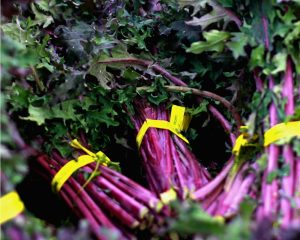 Kale, Red Russian – This variety of kale has tender, flat, slightly fringed leaves with a reddish-purple hue and a mild, sweet flavor. It is rich in vitamins A, C, and K, plus calcium, potassium, and antioxidants, which promote bone health, immunity, and heart health. Red Russian kale can be eaten raw in salads, sautéed, blended into smoothies, or added to soups and stews. This would be delicious in the winter added to a potato soup or vegetable stir fry. I love it sauteed with garlic and olive oil until bright green and tender. Store kale in the refrigerator, wrapped in a damp paper towel and placed in a plastic bag. Stored properly, it can stay fresh for up to a week. To freeze, wash and chop into small pieces and place in a freezer bag.
Kale, Red Russian – This variety of kale has tender, flat, slightly fringed leaves with a reddish-purple hue and a mild, sweet flavor. It is rich in vitamins A, C, and K, plus calcium, potassium, and antioxidants, which promote bone health, immunity, and heart health. Red Russian kale can be eaten raw in salads, sautéed, blended into smoothies, or added to soups and stews. This would be delicious in the winter added to a potato soup or vegetable stir fry. I love it sauteed with garlic and olive oil until bright green and tender. Store kale in the refrigerator, wrapped in a damp paper towel and placed in a plastic bag. Stored properly, it can stay fresh for up to a week. To freeze, wash and chop into small pieces and place in a freezer bag.
Fun fact: NASA has studied kale as a potential crop for space missions because of its high nutrient density. Per calorie, kale has more iron than beef and more calcium than milk. And one cup of raw kale has more vitamin C than a whole orange. (But don’t stop eating those other nutrient-packed foods!)
 Lettuce, Butterhead (Green) – Butterhead lettuce is a tender, mild-flavored leafy green known for its soft, buttery-textured leaves that form loose heads. It’s rich in vitamin K and folate, and because it’s about 95% water, it’s a hydration hero that helps keep you refreshed and nourished. Butterhead lettuce is best stored unwashed, wrapped loosely in a damp paper towel inside a plastic bag, and kept in the refrigerator’s crisper drawer, where it will stay fresh for about 5 to 7 days.
Lettuce, Butterhead (Green) – Butterhead lettuce is a tender, mild-flavored leafy green known for its soft, buttery-textured leaves that form loose heads. It’s rich in vitamin K and folate, and because it’s about 95% water, it’s a hydration hero that helps keep you refreshed and nourished. Butterhead lettuce is best stored unwashed, wrapped loosely in a damp paper towel inside a plastic bag, and kept in the refrigerator’s crisper drawer, where it will stay fresh for about 5 to 7 days.
Fun fact: Butterhead varieties like Boston and Bibb were once prized in royal European gardens for their delicate texture and subtle sweetness.
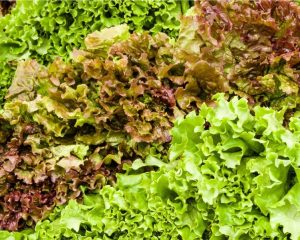
Lettuce, Loose Leaf – Leaf lettuce, known for its loose, leafy structure and mild, slightly sweet flavor, comes in green and red varieties. It is a low-calorie vegetable packed with vitamins A, C, and K, as well as folate and fiber, making it a nutritious choice for salads and wraps. Its tender leaves are best used raw in salads, sandwiches, or as a garnish. Store leaf lettuce in the refrigerator, loosely wrapped in a damp paper towel inside a plastic bag or container, and use it within a week to maintain freshness and crispness.
💡Tip: Don’t miss this exclusive Weekly Salad Greens Subscription to get the freshest greens in the Lehigh Valley every week!
Mushroom Varieties
Store mushrooms in a paper bag or breathable container in the refrigerator, avoiding moisture buildup, and only wash them right before use to maintain freshness.
Mushrooms are super versatile in the kitchen. Here are10 Things You Should Do With Mushrooms.
This roundup of 20 Mushroom Recipeshas you covered with meal ideas for breakfast, lunch, or dinner.
Mushroom, Portobello & Cremini – Portobello mushrooms are mature versions of cremini mushrooms, offering a meaty texture and rich, earthy flavor. Cremini, also known as “baby bellas,” are younger, smaller, and have a firmer texture with a milder taste. Both are low in calories, fat-free, cholesterol-free, and provide B vitamins, selenium, potassium, and antioxidants. Portobellos are ideal for grilling, roasting, or as a meat substitute in burgers, sandwiches, or stuffed recipes. Creminis are great for sautéing, adding to soups, stir-fries, pasta dishes, or as pizza and salad toppings.
Mushroom, Lion’s Mane – Lion’s mane mushrooms are known for their shaggy, white appearance and mild, slightly sweet, seafood-like flavor. Rich in antioxidants, they contain compounds that may support brain health, nerve regeneration, and immune function. These mushrooms can be sautéed, roasted, or added to soups and stir-fries, often used as a meat substitute due to their tender, meaty texture. Store them in a paper bag in the fridge and use within a few days for the best texture and flavor.
💡Tip: The artisan mushroom sampler is a great way to try different varieties of mushrooms. While we can’t predict or guarantee what will be included, the sampler often includes varieties such as enoki, oyster, shiitake, or trumpet.
 Onion, Fresh Bulb – Fresh bulb onions are early, fresh-picked onions harvested after overwintering in the field, with a mild flavor and tender texture that make them a welcome spring treat. They provide vitamin C, folate, antioxidants like quercetin, and sulfur compounds that may help reduce inflammation, lower cholesterol and blood pressure, and even offer antibacterial benefits. Sweeter and more delicate than cured storage onions, they’re delicious raw in salads, salsas, or quick pickles, and also shine when lightly sautéed. Store in the fridge, loosely wrapped or in a ventilated container; use greens within a few days and bulbs within a week for best flavor.
Onion, Fresh Bulb – Fresh bulb onions are early, fresh-picked onions harvested after overwintering in the field, with a mild flavor and tender texture that make them a welcome spring treat. They provide vitamin C, folate, antioxidants like quercetin, and sulfur compounds that may help reduce inflammation, lower cholesterol and blood pressure, and even offer antibacterial benefits. Sweeter and more delicate than cured storage onions, they’re delicious raw in salads, salsas, or quick pickles, and also shine when lightly sautéed. Store in the fridge, loosely wrapped or in a ventilated container; use greens within a few days and bulbs within a week for best flavor.
Fun Fact: The sulfur compounds in onions make your eyes water when chopped, but they also give onions their bold flavor and health benefits, so the tears are definitely worth it. To reduce the sting, chill onions before cutting or slice near an open window to help the compounds disperse.
 Rhubarb – Rhubarb is a unique perennial vegetable known for its vibrant red or green stalks. While technically a vegetable, it’s most often treated as a fruit in cooking, thanks to its tart, tangy flavor. Rich in vitamin K, fiber, and antioxidants, rhubarb is often used in desserts like pies, crumbles, and jams, though it can also complement savory dishes when paired with meat like pork. The leaves of rhubarb contain toxins and should never be eaten, but the stalks are perfectly safe to enjoy. Store rhubarb in the fridge, wrapped in a damp cloth or in a sealed plastic bag, and use within a week for the best flavor.
Rhubarb – Rhubarb is a unique perennial vegetable known for its vibrant red or green stalks. While technically a vegetable, it’s most often treated as a fruit in cooking, thanks to its tart, tangy flavor. Rich in vitamin K, fiber, and antioxidants, rhubarb is often used in desserts like pies, crumbles, and jams, though it can also complement savory dishes when paired with meat like pork. The leaves of rhubarb contain toxins and should never be eaten, but the stalks are perfectly safe to enjoy. Store rhubarb in the fridge, wrapped in a damp cloth or in a sealed plastic bag, and use within a week for the best flavor.
💡Tip: To reduce rhubarb’s natural tartness, cook it with some sugar or honey, or combine it with sweeter fruits like strawberries in desserts for a balanced flavor.
Fun Fact: Rhubarb was originally used in ancient Chinese medicine for its health benefits, long before it became a culinary favorite!
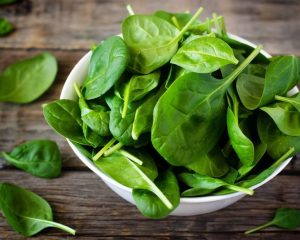 Spinach – Spinach is a nutrient-rich leafy green vegetable packed with vitamins A, C, K, folate, and minerals like iron and magnesium. Low in calories and high in antioxidants, it supports eye health, bone strength, and immune function. Spinach is versatile and can be enjoyed raw in salads, blended into smoothies, or cooked in soups, pasta, and omelets. To store, keep it dry in a perforated plastic bag in the fridge’s crisper drawer, and wash only before use. Properly stored, it stays fresh for 5-7 days.
Spinach – Spinach is a nutrient-rich leafy green vegetable packed with vitamins A, C, K, folate, and minerals like iron and magnesium. Low in calories and high in antioxidants, it supports eye health, bone strength, and immune function. Spinach is versatile and can be enjoyed raw in salads, blended into smoothies, or cooked in soups, pasta, and omelets. To store, keep it dry in a perforated plastic bag in the fridge’s crisper drawer, and wash only before use. Properly stored, it stays fresh for 5-7 days.
Fun Fact: During medieval times, spinach juice was used as ink for artwork due to its rich green pigment.
 Stinging Nettle – This wild, nutrient-rich leafy green is known for its fine, hair-like spines that sting when touched raw, though cooking, drying, or blending neutralizes the sting entirely. It has a mild, earthy flavor similar to spinach and has long been used in both culinary and herbal traditions. Nettles are packed with vitamins A, C, K, and B-complex, as well as iron, calcium, magnesium, potassium, and plant-based protein. They’re popular in soups, pestos, egg dishes, sautéed greens, and teas. Always blanch before eating to remove the sting. Store fresh nettles in the fridge wrapped in a damp paper towel inside a produce bag. Use within a few days, or blanch and either freeze or dry for long-term use.
Stinging Nettle – This wild, nutrient-rich leafy green is known for its fine, hair-like spines that sting when touched raw, though cooking, drying, or blending neutralizes the sting entirely. It has a mild, earthy flavor similar to spinach and has long been used in both culinary and herbal traditions. Nettles are packed with vitamins A, C, K, and B-complex, as well as iron, calcium, magnesium, potassium, and plant-based protein. They’re popular in soups, pestos, egg dishes, sautéed greens, and teas. Always blanch before eating to remove the sting. Store fresh nettles in the fridge wrapped in a damp paper towel inside a produce bag. Use within a few days, or blanch and either freeze or dry for long-term use.
‼️💡Important Tip: Always handle raw nettles with gloves or tongs.
Fun Facts: Stinging nettles aren’t just good for you—they’re good for the planet, too. Nettles grow abundantly without fertilizer and can be harvested multiple times a season. They’re considered a low-impact wild green, especially when foraged responsibly. Plus, they’re a favorite host plant for butterflies like the Red Admiral and Small Tortoiseshell, making them a quiet hero in supporting local pollinators and biodiversity.
 Sweet Potato, Fingerling – Sweet potato fingerlings are small, slender sweet potatoes with thin, edible skin and a naturally sweet, creamy texture. They are rich in fiber, beta-carotene, and vitamin C, promoting digestive and immune health. Roast, sauté, or air-fry them whole for a crispy skin and tender interior, or slice them into fries or hash. Store in a cool, dry place away from light, but avoid refrigeration as it can affect their texture.
Sweet Potato, Fingerling – Sweet potato fingerlings are small, slender sweet potatoes with thin, edible skin and a naturally sweet, creamy texture. They are rich in fiber, beta-carotene, and vitamin C, promoting digestive and immune health. Roast, sauté, or air-fry them whole for a crispy skin and tender interior, or slice them into fries or hash. Store in a cool, dry place away from light, but avoid refrigeration as it can affect their texture.
💡Tip: Roast whole or halved with herbs and spices for a simple side or mash with a touch of butter and cinnamon for a comforting dish.
 Tomatoes, Red Cherry – Red cherry tomatoes are small, sweet, and juicy with thin skins and vibrant flavor, perfect for raw snacking, salads, roasting, or tossing into pasta and grain bowls. Rich in lycopene, a powerful antioxidant linked to reduced cancer risk, they also offer vitamin C, potassium, and folate. Keep at room temperature out of direct sunlight for best flavor—refrigeration dulls their taste and texture, though very ripe ones can go in the fridge if needed and used soon.
Tomatoes, Red Cherry – Red cherry tomatoes are small, sweet, and juicy with thin skins and vibrant flavor, perfect for raw snacking, salads, roasting, or tossing into pasta and grain bowls. Rich in lycopene, a powerful antioxidant linked to reduced cancer risk, they also offer vitamin C, potassium, and folate. Keep at room temperature out of direct sunlight for best flavor—refrigeration dulls their taste and texture, though very ripe ones can go in the fridge if needed and used soon.
Fun Fact: Cherry tomatoes were once considered ornamental plants in Europe before becoming a kitchen staple. They tend to have higher sugar content than larger tomato varieties, which is why they burst with flavor even when raw.
 Watercress – Watercress is a peppery, nutrient-dense leafy green packed with antioxidants, vitamins A, C, and K, and beneficial plant compounds. Its crisp, slightly spicy flavor makes it excellent in fresh salads, sandwiches, and as a garnish for soups or main dishes. Store unwashed watercress in a sealed container or produce bag in the fridge for up to 3–5 days; wrap in a damp paper towel to help maintain freshness.
Watercress – Watercress is a peppery, nutrient-dense leafy green packed with antioxidants, vitamins A, C, and K, and beneficial plant compounds. Its crisp, slightly spicy flavor makes it excellent in fresh salads, sandwiches, and as a garnish for soups or main dishes. Store unwashed watercress in a sealed container or produce bag in the fridge for up to 3–5 days; wrap in a damp paper towel to help maintain freshness.
💡Tip: Use watercress in place of arugula or spinach for a sharper bite in salads or on pizza after baking.
Fun Fact: Watercress was once a staple for Roman soldiers and is one of the oldest known leaf vegetables consumed by humans.
Don’t forget: Online shopping opens Friday at 1 PM! 🛒 Stock your kitchen with these clean, nourishing ingredients to fuel your family with nutrient-dense meals. Be sure to grab your favorite staples and try something new for vibrant health this season.
Don’t wait to join…
Veggie E-Books
Download these collections of tips and recipes for each veggie. You’ll use these as a reference throughout the season.
Arugula E-Book
Asparagus E-Book
Beets E-Book
Bok Choy E-Book
Cabbage E-Book
Collard Greens E-Book
Fresh Herbs E-Book
Lettuce E-Book
Mushrooms E-Book
Scallion/Green Onion E-Book
Spinach E-Book
Tomatoes E-Book
We’ll keep farming for you!
Reuben and Tessa DeMaster
Willow Haven Farm


